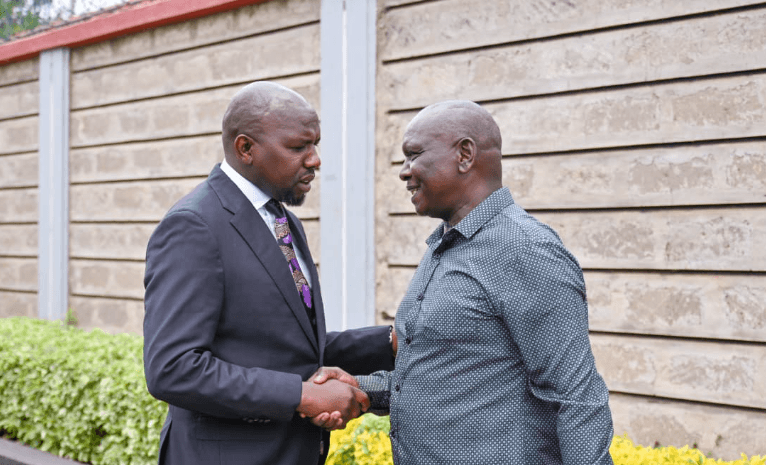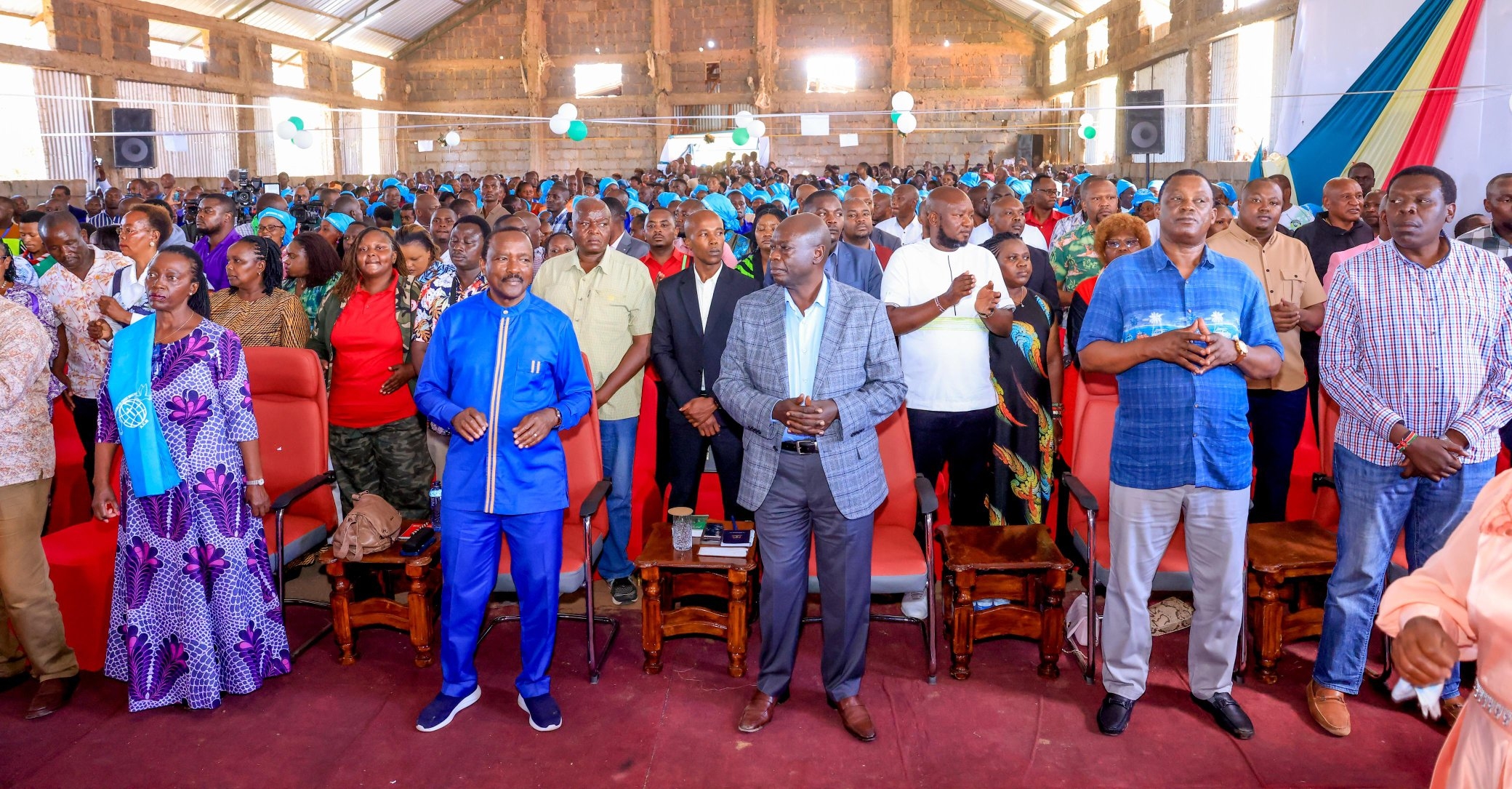@alalmaurice
For decades, Kochieng area in Kisumu county was known for chang'aa brewing.
But the story has changed and it is now a rice production scheme.
The scheme in Kadibo subcounty, which was started in 2020 by the National Irrigation Authority (NIA), now produces rice and other crops contributing to the country’s food basket.
Kochieng scheme patron Steve Tuju, 40, said residents engaged the authority to help transform the area for rice farming.
Kochieng is under Okana schemes which also comprises Kamdiri and Kagaya in Kochieng East location.
The three schemes have 7,500 acres, which can be put under rice production. Currently, the three schemes have 2,500 acres under rice production.
Kochieng has 1,500 acres put under rice farming besides other horticultural crops. It has the potential of producing rice on 2,500 acres.
Last year, the three schemes produced more than 5,000 tonnes of rice. Kochieng, being swampy, Tuju said, made it very difficult for other crops such as maize and sorghum to do well but it is good for rice production.
Initially, residents in partnership with the Kenya Breweries Limited ventured into sorghum farming but they quit due to low yields, he said.
They also tried maize farming but it failed due to excessive water in the area.
Despite depending on the rain-fed agriculture, Tuju said farmers averagely harvest between 40 and 45 bags of paddy rice on one acre in the scheme per season. This translates to about Sh200,000.
“In the last planting season, I got 76 bags of paddy rice from one and a half acres. The authority in partnership with JICA has been very supportive to farmers. They gave us fertiliser,” he said.
Tuju said farmers expect a bumper harvest because of sufficient water and other farm inputs in the scheme this season.
“We expect to start harvesting from August, September and October. We thank the government for the subsidy fertiliser which has been very helpful to farmers,” he said.
Tuju, however, called for the reduction of fertiliser prices and more investment in infrastructure to enhance rice production.
“We are appealing to the government to reduce the price of urea fertiliser from Sh3,500 to Sh2,500 and sulfate fertiliser to Sh2,000 to make them affordable to farmers,” he said.
The 2,500-acre capacity scheme currently has more than 200 farmers, with the number expected to rise due to the ongoing expansion.
Rice farming, he said, has improved the livelihoods of locals as they are able to provide food for their families and pay school fees because of increased income.
The scheme has also helped eradicate consumption of illicit brews as residents are productively engaged in their farms unlike before.
“Right now, the youths are busy on farms. The den is no more and those who used to brew chang'aa have embarked on farming,” Tuju added.
After four months, they earn between Sh150,000 and Sh200,000 unlike before where one had to sell land to make such kind of money.
Tuju said rice production has really changed the lives of residents as they are able to pay their bills. In the scheme, they are planting Kwamboka, IR, IRS and basmati.
Farmers have embraced a non-aromatic variety of rice to cut losses caused by birds invasion.
Farmer Kingstone Oduor said illicit brew was synonymous with the area before the authority embarked on expansion of the scheme for rice production.
The scheme has improved education apart from livelihoods because in acres they earn more than Sh150,000, Oduor said.
Oduor, 27, urged young people to embrace farming which pays instead of waiting for white collar jobs. He owns a tractor which he bought from the farming proceeds.
With his tractor, the former horticulture farmer makes Sh4,200 per acre when he ploughs other farmers land.
Oduor, who sat his KCSE exam in 2017, started growing tomatoes before he fully embarked on local vegetables.
“In every planting season, I could make Sh3,500 per week from vegetables on half an acre before expanding farming to 1.5 acres. This made me develop more interests in farming,” he said.
He later ventured into watermelon farming before shifting to rice production on two acres. He then expanded to four acres.
From the earnings, Oduor opened an account where he saved towards buying the tractor. After two years of growing vegetables, he said rice farming improved his income.
He harvests close to 180 bags of paddy rice from four acres, translating into about Sh800,000.
Moses Aguko shifted from growing tomato to rice farming because of the high yields of the crop. He said the returns from tomato farming were not good as compared to rice.
“I would spend a lot of money growing tomatoes but with little returns making me venture into rice farming which has increased my income,” he said.
Aguko remains optimistic of high yields from his five-acre land.
He expects to harvest more than 40 bags from every acre.
Jemimah Akinyi Otieno, a farmer and mother of three, started rice farming in 2022 and harvested more than 80 bags of paddy rice.
Last year, she planted rice on her 2.5 acres and harvested 88 bags, which enabled her to pay school fees for her children and feed family.
Kochieng East chief Peninah Opondo said the scheme has improved the livelihoods of residents.
“Rice farming has massively reduced cases of illicit brews in the location. Our young people are busy on farms,” Opondo, who also grows rice at the scheme, said.
She expects to harvest 720 bags of paddy rice from her 18 acres this season.
On average one kilo of paddy rice costs between Sh55 and Sh63. In 2022, Opondo said she got 220 bags of paddy rice from eight acres.
But in 2021, she only harvested 45 bags from seven acres due to birds’ invasion.
Western Kenya Schemes (WKS) manager Kennedy Ouma said Okana schemes produced 5,302 tonnes of paddy rice under 2,652 acres. This translated to Sh212.1 million in value.
WKS comprises Ahero, West Kano, South West Kano and community irrigation schemes in the region, with more than 16,000 acres under crop production.
In the last three years, WKS has been undertaking expansions and supporting other outgrower schemes such as Okana, Mbega, Kore, Nokiso and Masune.
Ouma said Okana schemes have the potential of 7,500 acres, NIA has already opened up 2,651 acres for rice production. The expansion is ongoing.
In the Mbega scheme with 1,200 acres, the authority has undertaken expansion. It produced 2,400 tonnes worth Sh96 million while Kore with 650 acres produced 1,300 tonnes of rice worth Sh52 million.
Nokiso and Masune with 2,000 acres and 500 acres respectively produced 4,000 tonnes (Sh160 million) and 1,000 tonnes (Sh40 million). South West Kano has 5,000 acres under rice production.
Ouma said they are supporting more than 5,000 farmers under the community schemes. Currently, farmers in Okana depend on seasonal streams which sometimes reduce water supply.
To mitigate the challenge, the authority has built control structures with plans to enable farmers to get enough water in the scheme.
The manager said there are plans to expand the remaining 5,000 acres within Okana schemes. The expansion initiatives targets to increase food production in the region.
Kenya’s annual rice production stands at an average of 180,000 tonnes of rice against the consumption estimates of 720,000 tonnes. Ouma said WKS contributes approximately 35,316.4 tonnes (20 per cent) of local production.
Last year, WSK produced 33,000 tonnes of paddy rice against a projection of 38,000 tonnes, a difference of 5,000 due to bird invasion and lack of sufficient water supply in some schemes.
This year, Ouma said they have a projection of 40,000 tonnes of paddy rice. The authority has partnered with various stakeholders to teach farmers in new farming methods.
Farmers, he said, have embraced mechanical harvesters which will see production significantly increased in the region.
NIA has partnered with JICA on capacity building for both staff and farmers through development of rice, farming technologies and sensitisation of farmers for the adoption of these technologies.
They have also introduced combined harvesters that have cut down post-harvest losses by over 0.5 tonnes per acre (Sh20,000).
The combination of improved technologies has seen an increase in yields from two tonnes per acre to close to 2.8 tonnes per acre.
Apart from technologies, WSK has received a grant of Sh72 million worth of fertiliser to facilitate farmers. It translated to 26,000 bags of fertiliser.
“The fertiliser was customised to our soil health conditions from which we saw an increase in yields from two tonnes per acre to 2.6 tonnes per acre,” Ouma added.
Farmers have embraced a non-aromatic variety of rice to reduce losses caused by birds invasion.
Last season farmers incurred losses of close to Sh2 million as about 4,000 tonnes of rice were destroyed by birds. The expansions target to add 14,000 tonnes of rice to the national food basket.
Ouma said WKS was faced with high cost of electricity bill, dilapidated infrastructure, high production cost, pest and diseases, flood and climate change, and low productivity, among others.
In Ahero and West Kano Irrigation Schemes alone, the authority spends Sh30 million to abstract water from Lake Victoria.
“We are appealing to the government to speed up the construction of the Koru-Soin dam. Upon completion, we will be able to deliver water by gravity,” he said.











